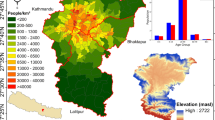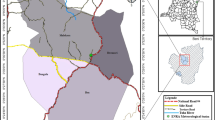Abstract
The main objective of this study is to know the current state of thermal discomfort and its changes in the coming decades in one of the semi-arid climates of Iran. This study is very important considering the importance and direct impact of climate change and global warming on human health and can help adopt preventive policies to face them properly. Thermal discomfort changes were assessed by the temperature-humid index (THI) and effective temperature (ET) in Arak City as a representative of the semi-arid climate of Iran. The modeling was done using the CanESM2 general circulation model. The statistical downscaling model (SDSM) software was used to downscale the model data in the period of 2011 to 2099 with three different scenarios of optimistic (RCP 2.6), intermediate (RCP 4.5), and pessimistic (RCP 8.5). The results showed that based on all three scenarios, the values of THI in January, February, and May in the coming decades will be higher than the base values (1976–2005), which will indicate an increase in thermal discomfort in these months. The pattern of changes based on the ET index was almost similar to the THI except in the optimistic scenario in all periods. In this scenario, there is a slight downward trend from 8.1% in the base period to 1.9%, 4.3%, and 3.7% in the decades 2011 to 2040, 2041 to 2070, and 2071 to 2099, respectively. In general, the increasing temperature in the study area based on all three scenarios will cause major changes in thermal comfort, so that thermal discomfort increases not only in hot seasons, but also in other seasons.



Similar content being viewed by others
Data availability
The datasets generated during and/or analyzed during the current study are not publicly available but are available from the corresponding author on reasonable request.
References
Abbasi F, NokhandanHabibi M, Mokhtari L, Malbosi S (2009) Assessment of the impact of climate change on temperature and precipitation in Iran in the coming decade suing MAGICC- SCENGEN model. Phys Geogr Res 72:91–110
Ahmadi H, Ghalhari GF, Baaghideh M (2019) Impacts of climate change on apple tree cultivation areas in Iran. Clim Change 153(1):91–103
Asghari M, Teimori G, Abbasinia M, Shakeri F, Tajik R, Ghannadzadeh MJ, Ghalhari GF (2019) Thermal discomfort analysis using UTCI and MEMI (PET and PMV) in outdoor environments: case study of two climates in Iran (Arak & Bandar Abbas). Weather 74:S57–S64
Asghari M, Ghalhari GF, Abbasinia M, Shakeri F, Tajik R, Ghannadzadeh MJ (2020) Feasibility of relative strain index (RSI) for the assessment of heat stress in outdoor environments: case study in three different climates of Iran. The Open Ecol J 13(1):11–18
Balogun IA, Daramola MT (2019) The outdoor thermal comfort assessment of different urban configurations within Akure City. Nigeria Urban Clim 29:100489
Bedia J, Herrera S, Gutiérrez JM, Benali A, Brands S, Mota B, Moreno JM (2015) Global patterns in the sensitivity of burned area to fire-weather: Implications for climate change. Agric Meteorol 214:369–379
Bienvenido-Huertas D, Rubio-Bellido C, Marín-García D, Canivell J (2021) Influence of the representative concentration pathways (RCP) scenarios on the bioclimatic design strategies of the built environment. Sustain Cities Soc 72:103042
Chen J, Mueller V (2018) Coastal climate change, soil salinity and human migration in Bangladesh. Nat Clim Chang 8(11):981–985
Chou SC, Lyra A, Mourão C, Dereczynski C, Pilotto I, Gomes J, Bustamante J, Tavares P, Silva A, Rodrigues D (2014) Assessment of climate change over South America under RCP 4.5 and 8.5 downscaling scenarios. Am J Clim Change 3(05):512
Falah G, Mosavei S, Habibinokhandan M, Khoshal G (2009) Seasonal rainfall forecasting based on synoptical patterns using phasic sets theory. Geogr Dev Iranian J 7(15):113–132
Flato G, Marotzke J, Abiodun B, Braconnot P, Chou S, Collins W, Cox P, Driouech F, Emori S, Eyring V (2013) Climate change 2013: the physical science basis. Contribution of working group I to the fifth assessment report of the Intergovernmental Panel On Climate Change. Evaluation of Climate Models, eds TF Stocker, D Qin, G-K Plattner, M Tignor, SK Allen, J Boschung, et al.(Cambridge: Cambridge University Press)
Fowler HJ, Blenkinsop S, Tebaldi C (2007) Linking climate change modelling to impacts studies: recent advances in downscaling techniques for hydrological modelling. Int J Climatol 27(12):1547–1578
Gasparrini A, Guo Y, Sera F, Vicedo-Cabrera AM, Huber V, Tong S, de Coelho MSZS, Saldiva PHN, Lavigne E, Correa PM (2017) Projections of temperature-related excess mortality under climate change scenarios. Lancet Planet Health 1(9):360–367
Gebrechorkos SH, Hülsmann S, Bernhofer C (2019) Statistically downscaled climate dataset for East Africa. Sci Data 6(1):1–8
Ghalhari GF, Dehghan SF, Shakeri F, Ghanadzadeh MJ, Asghari M (2020) Assessing the monthly changes of heat stress indices in outdoor environment during a 15-year period: case of study in a dry and warm climate. Urban Clim 31:100538
Ghalhari GF, Dehghan SF, Pirposhteh EA, Teimori G, Basati M, Asghari M (2021) Applicability of air enthalpy for heat stress assessment of outdoor environments in different climates of Iran. Theor Appl Climatol 145:1233–1242
Ghalhari GF, Shakeri F, Dadashi-Roudbari A (2019) Impacts of climate changes on the maximum and minimum temperature in Iran. Theoret Appl Climatol 138(3):1539–1562
Goshua A, Gomez J, Erny B, Burke M, Luby S, Sokolow S, LaBeaud AD, Auerbach P, Gisondi MA, Nadeau K (2021) Addressing climate change and its effects on human health: a call to action for medical schools. Acad Med 96(3):324–328
Grigore E (2013) Interannual variation of the average values of thermo-hygrometer index on the south dobrogea territory. Present Environ Sustain Dev 7:215–223
Hassan Z, Shamsudin S, Harun S (2014) Application of SDSM and LARS-WG for simulating and downscaling of rainfall and temperature. Theoret Appl Climatol 116(1):243–257
Heidari H, Golbabaei F, Shamsipour A (2016) Determination of air enthalpy based on meteorological data as an indicator for heat stress assessment in occupational outdoor environments, a field study in Iran. J Res Health Sci 16(3):133
Heidari H, Golbabaei F, Shamsipour A, Forushani AR, Gaeini A (2018) Consistency between sweat rate and wet bulb globe temperature for the assessment of heat stress of people working outdoor in arid and semi-arid regions. Int J Occup Environ Med 9(1):1
Heidari H, Golbabaei F, Shamsipour A, RahimiForushani A, Gaeini A (2018) The cut-off point for tympanic temperature as a heat strain index for evaluation of outdoor workers: a field study. Int J Occup Saf Ergon 24(2):224–232
Heidari H, Golbabaei F, Shamsipour A, Rahimi-Forushani A (2019) Occupational heat stress in outdoor settings considering the regional climate change in the future decades in Iran. Iran Occup Health 16(2):33–47
Hua W, Chen H, Sun S, Zhou L (2015) Assessing climatic impacts of future land use and land cover change projected with the CanESM2 model. Int J Climatol 35(12):3661–3675
Kjellstrom T, Kovats RS, Lloyd SJ, Holt T, Tol RS (2009) The direct impact of climate change on regional labor productivity. Arch Environ Occup Health 64(4):217–227
Koolivand A, Ghanadzadeh MJ, Rajaei MS, Saeedi R, Mohamadtaheri A, Seifi D (2021) Spatiotemporal distribution of PM10 and PM2. 5 within and around the city of Arak, Iran: effect of natural sources. Iranian J Health Saf Environ 7(2):1428–1436
Kreslake JM, Price KM, Sarfaty M (2016) Developing effective communication materials on the health effects of climate change for vulnerable groups: a mixed methods study. BMC Public Health 16(1):1–15
Majidi FA, Heidari S (2019) Analysis of adaptability signs in the thermal comfort of open spaces (Case study: Isfahan residential neighborhoods). Honar – ha – ye – Ziba-Memari-Va-Shahrsazi 24(1): 17–28
Mehta DJ, Yadav S (2022) Long-term trend analysis of climate variables for arid and semi-arid regions of an Indian state Rajasthan. Int J Hydrol Sci Technol 13(2):191–214
Mohammadi H, Ranjbar F (2010) Study of changes in precipitation and temperature using MAGICC- SCENGEN model. Geography 8(25):125–142
Nassiri P, Monazzam MR, Golbabaei F, Shamsipour A, Arabalibeik H, Mortezapour AR, Teimori G, Asghari M (2018) Applicability of modified discomfort index (MDI) in outdoor occupational environments: a case study of an open pit mines in Tehran Province.". Iran Occup Health 15(1):136–145
Nassiri P, Reza Monazzam M, Golbabaei F, Abbasinia M, Chavoshi M, Taheri F, Asghari M (2018b) Exposure to heat stress in the workplace: a systematic review. Iran Occup Health 15(2)
Phillips BD, Morrow BH (2007) Social science research needs: focus on vulnerable populations, forecasting, and warnings. Nat Hazard Rev 8(3):61–68
Solomon S, Qin D, Manning M, Chen Z, Marquis M, Averyt KB, Tignor M, Miller HL (2007) The physical science basis. Contribution of working group I to the fourth assessment report of the intergovernmental panel on climate change. Available at: http://www.ipcc.ch/publications_and_data/ar4/wg1/en/contents.html. Intergovernmental Panel Clim Chang (IPCC)
Stocker TF, Qin D, Plattner G-K, Tignor M, Allen SK, Boschung J, Nauels A, Xia Y, Bex B, Midgley B (2013) IPCC, 2013: climate change 2013: the physical science basis. Contribution of working group I to the fifth assessment report of the Intergovernmental Panel On Climate Change, Cambridge University Press
Tavakol-Davani H, Nasseri M, Zahraie B (2013) Improved statistical downscaling of daily precipitation using SDSM platform and data-mining methods. Int J Climatol 33(11):2561–2578
Tseliou A, Tsiros IX, Lykoudis S, Nikolopoulou M (2010) An evaluation of three biometeorological indices for human thermal comfort in urban outdoor areas under real climatic conditions. Build Environ 45(5):1346–1352
van Loenhout JAF, Vanderplanken K, de Almeida MM, Kashibadze T, Giuashvili N, Gamkrelidze A (2021) Heatwave preparedness in urban Georgia: a street survey in three cities. Sustain Cities Soc 70:102933
Vicedo-Cabrera AM, Scovronick N, Sera F, Royé D, Schneider R, Tobias A, Astrom C, Guo Y, Honda Y, Hondula D (2021) The burden of heat-related mortality attributable to recent human-induced climate change. Nat Clim Chang 11(6):492–500
Wilby RL, Dawson CW, Barrow EM (2002) SDSM—a decision support tool for the assessment of regional climate change impacts. Environ Model Softw 17(2):145–157
Wilks DS (2010) Use of stochastic weathergenerators for precipitation downscaling. Wiley Interdisc Rev: Clim Chang 1(6):898–907
Zoghi M, Ehsani AH, Sadat M, JavadAmiri M, Karimi S (2017) Optimization solar site selection by fuzzy logic model and weighted linear combination method in arid and semi-arid region: a case study Isfahan-IRAN. Renew Sustain Energy Rev 68:986–996
Acknowledgements
This research has been sponsored by the Arak University of Medical Sciences (grant no.3679). The authors would like to highly appreciate the university cooperation as well as Iran Meteorological Organization for the provision of required data.
Funding
This research has been sponsored by the Arak University of Medical Sciences (grant no.3679).
Author information
Authors and Affiliations
Contributions
All authors contributed to the study conception and design. Material preparation, data collection and analysis were performed by Mehdi Asghari, Gholamabbas Fallah Ghalhari, Rahmatollah Moradzadeh, Reza Tajik, Sadegh Samadi, Mohammadjavad Ghanadzadeh, and Hamidreza Heidari. The first draft of the manuscript was written by Hamidreza Heidari, and all authors commented on previous versions of the manuscript. All authors read and approved the final manuscript.
Corresponding author
Ethics declarations
Ethics approval
This study was performed in line with the principles of the Declaration of Helsinki. Approval was granted by the Ethics Committee of Arak University of Medical Sciences (IR.ARAKMU.REC.1399. 164).
Competing interests
The authors declare no competing interests.
Additional information
Publisher's note
Springer Nature remains neutral with regard to jurisdictional claims in published maps and institutional affiliations.
Rights and permissions
Springer Nature or its licensor (e.g. a society or other partner) holds exclusive rights to this article under a publishing agreement with the author(s) or other rightsholder(s); author self-archiving of the accepted manuscript version of this article is solely governed by the terms of such publishing agreement and applicable law.
About this article
Cite this article
Asghari, M., Ghalhari, G.F., Ghanadzadeh, M. et al. Modeling of thermal discomfort based representative concentration pathways (RCP) scenarios in coming decades using temperature-humidity index (THI) and effective temperature (ET): a case study in a semi-arid climate of Iran. Air Qual Atmos Health 16, 1195–1205 (2023). https://doi.org/10.1007/s11869-023-01335-y
Received:
Accepted:
Published:
Issue Date:
DOI: https://doi.org/10.1007/s11869-023-01335-y




